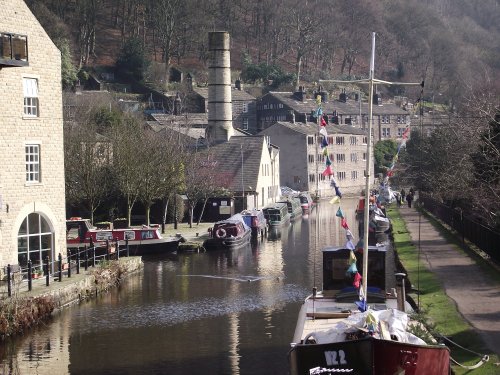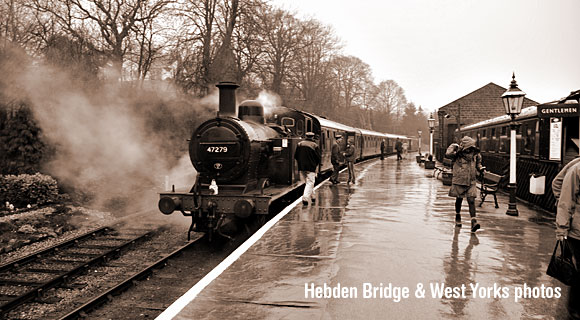Our next walks venue will be in the Upper Calder Valley of West Yorkshire from
Hebden Bridge
on
Saturday 11th June 2011
0800hrs prompt from the Short Stay Car Park
Dehydration can be a serious problem in warmer months leading to loss of energy, loss of alertness, aching joints and being a liability to your fellow walkers. Please ensure that you have a plentiful supply of drinking water [cordial]. 2 litres is recommended.
Dehydration can be a serious problem in warmer months leading to loss of energy, loss of alertness, aching joints and being a liability to your fellow walkers. Please ensure that you have a plentiful supply of drinking water [cordial]. 2 litres is recommended.
We last visited Hebden Bridge in 1997 [November] so it will be a new area for many and a welcome return for the rest.
This beautiful old town grew up close to the River Hebden at the point where a stone bridge was built as part of a pack-horse route in the 16th century.
By the time of the 18th century Hebden Bridge had become a noted centre for weaving. Stone cottages appeared, these were especially built for weavers with wider than usual windows to allow for the maximum of light. In the 18th century it was commonplace for many workers in the textile industry to work at home, and it was only at the latter end of the century that mills began to be established in the town, bringing with them a much needed prosperity. You only have to cast your eye's above the crowded shop windows of the main streets, to note the flurry of building work which took place once more money was available. Some of these fine properties still show the lovely facades of yester-year.
In the town is the Robin Hood, a coaching inn from the 17th century. The inn retains much of its earlier character, and is believed to have an old well from which St.Thomas a Becket took a cup of water.
This is Bronte country where the terrain is of deep sided valley's and glens lying beneath lonely moors were visitors can see golden gorse, bracken and heather. A wealth of wildlife saunters the moors, grouse, pheasant, partridge, and the inevitable fox. In the skies above you might be lucky and catch sight of Kite or Eagle.
At Hebden Water, a few miles from Hebden Bridge is an area known as the "Crags" here, miles of footpaths take you on a nature trail of the areas natural and archaeological history, passing through dense woodland, alive with oak, ash, beech, and pine. In springtime these lofty trees spread their branches over a carpet of vibrant gently nodding bluebells who contrast sharply with the tawny autumnal shades to come.
In the 19th century dams and weirs on Hebden Water controlled the water supply to mills like Gibson Mill. A three storey building of the early 18th century, this was one of the first mills of the Industrial Revolution. It has recently been restored and brought back to life as an interesting visitors centre by the National Trust. The mill offers hands on exhibitions and gives you the opportunity to learn of the people who toiled here for up to 72 hours a week, and often for very little reward.
Before the restoration programme for Gibson Mill commenced it was used by the community of Hebden Bridge as a venue for part of their annual Christmas celebrations. A delightful late afternoon walk through beautiful countryside to Gibson Mill was followed by a candle-lit carol service, warming punch and mince pies. The noisy return journey led by wassailers with lantern transformed the woods into a starry "fairy glen". With the completion of the project it is hoped the Wassailers walk to Gibson Mill will be re-introduced. Interestingly, the mill was used as a setting for scenes in the recent production of Nicholas Nickleby.
A local tradition here is the ancient "pace-egg play" this takes place each Good Friday when a colourful procession parades through the streets.
The visitor here is thrice blest, you have the joy of a lovely old town, the pleasures of spectacular countryside and the nearness of Halifax, a town full of lovely buildings and noted landmarks.
By the time of the 18th century Hebden Bridge had become a noted centre for weaving. Stone cottages appeared, these were especially built for weavers with wider than usual windows to allow for the maximum of light. In the 18th century it was commonplace for many workers in the textile industry to work at home, and it was only at the latter end of the century that mills began to be established in the town, bringing with them a much needed prosperity. You only have to cast your eye's above the crowded shop windows of the main streets, to note the flurry of building work which took place once more money was available. Some of these fine properties still show the lovely facades of yester-year.
In the town is the Robin Hood, a coaching inn from the 17th century. The inn retains much of its earlier character, and is believed to have an old well from which St.Thomas a Becket took a cup of water.
This is Bronte country where the terrain is of deep sided valley's and glens lying beneath lonely moors were visitors can see golden gorse, bracken and heather. A wealth of wildlife saunters the moors, grouse, pheasant, partridge, and the inevitable fox. In the skies above you might be lucky and catch sight of Kite or Eagle.
At Hebden Water, a few miles from Hebden Bridge is an area known as the "Crags" here, miles of footpaths take you on a nature trail of the areas natural and archaeological history, passing through dense woodland, alive with oak, ash, beech, and pine. In springtime these lofty trees spread their branches over a carpet of vibrant gently nodding bluebells who contrast sharply with the tawny autumnal shades to come.
In the 19th century dams and weirs on Hebden Water controlled the water supply to mills like Gibson Mill. A three storey building of the early 18th century, this was one of the first mills of the Industrial Revolution. It has recently been restored and brought back to life as an interesting visitors centre by the National Trust. The mill offers hands on exhibitions and gives you the opportunity to learn of the people who toiled here for up to 72 hours a week, and often for very little reward.
Before the restoration programme for Gibson Mill commenced it was used by the community of Hebden Bridge as a venue for part of their annual Christmas celebrations. A delightful late afternoon walk through beautiful countryside to Gibson Mill was followed by a candle-lit carol service, warming punch and mince pies. The noisy return journey led by wassailers with lantern transformed the woods into a starry "fairy glen". With the completion of the project it is hoped the Wassailers walk to Gibson Mill will be re-introduced. Interestingly, the mill was used as a setting for scenes in the recent production of Nicholas Nickleby.
A local tradition here is the ancient "pace-egg play" this takes place each Good Friday when a colourful procession parades through the streets.
The visitor here is thrice blest, you have the joy of a lovely old town, the pleasures of spectacular countryside and the nearness of Halifax, a town full of lovely buildings and noted landmarks.
There will be three walks as normal;
- A Walk led by:- Steve Edwards
- B Walk led by:- Joan Hilton and Shirley Fairnie
- C Walk led by:- George Mann
Details of the walks will be added as soon as they become available, but by Saturday 4th June
More photos of the town
More photos of the town


No comments:
Post a Comment